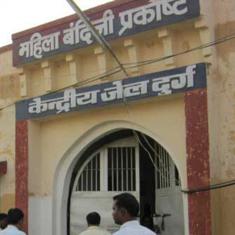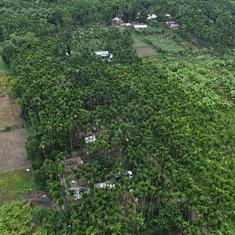Most Indian cities are being developed rapidly without paying heed to their natural ecology, Climate Change and its impact. Far from being nature-led, the planning of cities is poor which is evident, among other instances, when a city floods even with a little rain.
Mumbai ranks among the world’s ten cities where rising sea level can cause erosion of its ecosystems worsening the effect of storm surges and flooding. Its preparedness for present challenges is far from adequate while the need is to prepare for more frequent once-in-25-years floods.
What should Mumbai’s planners bear in mind as they plan for the future, what can the city expect as Climate Change and sea level rise add to the floods, what risks are on the horizon are some of the queries that Questions of Cities posed to the well-known atmospheric scientist Adam H Sobel, professor at Columbia University’s Lamont-Doherty Earth Observatory and Engineering School, who studied Mumbai.
Sobel works on, among other things, the dynamics of climate and weather phenomena, with a focus on understanding the risks to human society from extreme weather and Climate Change.
He is the author of Storm Surge, a book about Superstorm Sandy, and has hosted Deep Convection, a podcast featuring real conversations between climate scientists. Sobel speaks about, among other aspects, how Mumbai’s infrastructure projects – current favourite of governments – increase its risk of flooding.
Have you tracked or seen major shifts in the way Indian cities, especially Mumbai, addressed Climate Change impact in the last few years? What has been different?
I cannot claim to be an expert in the policies of Indian city or state governments. I do try to follow what is happening in Mumbai, mostly from a distance and then from visits over a few years, the most recent in late 2019. It is good to see governments in Maharashtra and Mumbai that seem to take the city’s climate risk more seriously, as it deserves. The new flood early warning system by the Ministry of Earth Sciences looks state-of-the-art, from what I understand, but I would like to know more about how the warnings are used.
There does seem to be increased awareness of Mumbai’s great vulnerability, as a very low-lying island city with both enormous population and enormous wealth in the harm’s way via sea level rise, flood risk and cyclones. I do not know if this awareness has had any impact on the city’s rapid development, including along the highest-risk parts of the coastline.
It is now established, by studies and scientific models, that the cyclone risks to India’s coastal cities have aggravated. What steps would you expect India’s government to take to minimise possible damage to people and property?
Cyclone activity has increased in recent decades in the Arabian Sea in particular. Attribution studies by Hiroyuki Murakami and others at Princeton University have used high-resolution climate model simulations to argue that an Arabian Sea increase is an expected consequence of human-induced global warming. The winds and rains produced by cyclones are increasing, on average, globally. And sea level rise amplifies coastal flood risk, especially in low-lying cities like Mumbai.
India’s government, as governments in other high-risk countries including the United States, where I live, would be well advised to think proactively about the most effective and equitable ways to manage this increasing risk. Pressures to develop the coastline are hard for governments to resist, especially in economically hyper-active megacities like Mumbai. Hence the infrastructure projects being planned and built now, many of which are on the most low-lying and vulnerable lands, including along the Arabian Sea and Thane Creek, increase Mumbai’s risk even further over what it already was. The state, local, and federal governments would be wise to find alternatives to these high-risk projects.

Your study at Columbia University showed that major cyclone and storm surges used to be historical once-in-a-hundred-year events in Indian cities but that was changing. Would you elaborate on this and the possible reasons for it?
Our study of Mumbai’s cyclone risk did not actually explicitly look at Climate Change, but only at Mumbai’s historical risk. We hope to update it to look at the Climate Change signal. The Princeton study by Murakami et al. did look at the Climate Change signal, and found that the increased Arabian Sea cyclone activity in recent decades is a consequence of warming.
The big climate-related disasters are, in your words, “sufficiently rare” in cities which, therefore, do not factor them into planning or building cities. Are we at a point where cities must consider such events as common occurrences as they plan for the next two-three decades?
Cities tend to be reasonably well adapted to events that occur frequently. Rare events – those that occur, on average, less frequently than something like once every hundred years – tend not to be planned for or built for very well, unless one has happened recently.
With climate change, some kinds of events are happening more frequently, and planning should definitely account for them. The recent floods in Mumbai (2005, 2017, 2019) may be among them, and cyclones may be as well, considering the model projections as well as the recent near-misses of Cyclones Ockhi and Nisarga. What this means is that no one should still be planning based solely on historical data; that is not an adequate guide to the future. Predictive science is needed, including climate models.
Advanced climate models by researchers in Princeton University some years ago predicted a 46% rise in cyclones in the Arabian Sea and a 31 percent decline in the Bay of Bengal. How would you explain this?
Climate models project that the Arabian Sea warms disproportionately more than other regions, including the Bay of Bengal, from greenhouse gas emissions, as a consequence of monsoon changes. This relative warming favours cyclones in the Arabian Sea. So, they are likely to be more here.
Sea-level rise, another manifestation of Climate Change, is now threatening many of India’s coastal cities though the extent of its impact is still being debated. What would you say to those who argue that it’s an overblown risk?
Sea level rise is a certainty, and it is one of the aspects of global warming that takes the longest to fully materialise. So sea level will increase, far into the future, even if emissions stop soon (and they show no sign of doing that, so it will increase yet more). And sea level becomes a problem to coastal areas long before they are permanently inundated, because a higher sea level increases the risk of coastal flooding due to storm surge, or eventually just high tides. Given how many people and how much economic value resides close to the coast around the world, it is difficult to overstate this risk.

Please elaborate on how sea-level rise combined with extreme rain or storm surge impacts a city like Mumbai.
Storm surge is the elevation of the water above where it would otherwise be, due to wind. The total water level in a coastal flood event is the storm surge plus the tide plus the mean sea level. If mean sea level is higher, the same storm produces greater flooding. When there is heavy rain at the same time, the higher sea level obstructs the drainage of rivers into the sea, thus also increasing freshwater flooding and creating what we call a “compound” flood event.
You have repeatedly spoken of the need to rely more on science in assessing risks and impacts of Climate Change. In your testimony to the US House of Representatives in 2019, you spoke of using observation, models and theory in predicting extreme weather events. What is your assessment of how governments and policy makers approach this, is science informing policy?
The science of defining climate risk in the most practical way for cities is still developing, but governments should engage with scientists in academia and the private sector as well as their own agencies to try to get the most relevant forward-looking views. In the United States and Europe, there is a rapidly growing private sector in this space because of demands for climate risk disclosure.
Some of the same science can be used for urban planning, but it would be best if it were done in an open-source manner rather than using proprietary models as the private sector tends to do. Governments should be accountable to their citizens, and that starts from being open about the scientific information that is going into decisions.
India should also do what it can to make its own energy infrastructure as low-carbon as possible. Of course, the country needs energy for its development and deserves relatively little blame for the current state of the climate because its own emissions have been historically quite low. But there is no need to repeat the bad decisions made by other nations (my own especially among them) by investing in yet more fossil fuel infrastructure – the future will be decarbonised, and it’s better to be ahead of the curve than behind it.
What do you see happening in India in the above context, are governments and policy makers paying attention to scientific and observation-model-theory approaches? Is Mumbai on track here?
I am not in a position to make an authoritative or comprehensive statement about how policy makers in India are using science (or are not). I can say that the development of key coastal cities, including Mumbai and Chennai, to name just two I have visited, is not being done in a way that is sensitive to the cities’ extreme climate risks – if it were, there would be less building of roads, buildings, ports, coal plants, etc., along fragile and vulnerable coasts, wetlands, and riverine floodplains. These cities are being set up for even worse future disasters than would otherwise be necessary.
In the area of emergency management, on the other hand, there has been impressive progress. Recent severe cyclones on the eastern coast have caused much less loss of life than they would have in the past, due to effective forecasts, warnings, and evacuations. I hope the new flood warning system in Mumbai will be similarly effective. Evacuations would be much more difficult in Mumbai, but one can at least plan ahead of time so that the best possible decisions can be made in the moment.

In the same testimony, you averred that “…with respect to extreme weather…changes in the future will be greater than in the past or present”. Would you elaborate on this?
I just meant there that as the climate continues to warm, we will see more “unprecedented” extreme weather events of various kinds – especially heat waves, droughts, floods, and cyclones – because the climate as a whole will be warmer than it has been at any time since before the human species evolved.
Uncertain science should not be a reason to delay action on Climate Change, you stated in the past. What sort of delayed actions are you seeing on this issue and what level would it be at – international organisations, governments, big business?
The biggest problem is that governments of most countries, but especially the highest-emitting ones, have been far too slow to acknowledge the severity of the problem and stop burning fossil fuels. My own country, the United States, is foremost among these. While the proximate problem is lack of action by our federal government, the ultimate cause is that we are a petrostate in which the fossil fuel industry has great influence. This explains the climate denial movement’s strength here, and our government’s failure to lead, or even participate particularly constructively, in international climate negotiations, over most of their history (the Paris Agreement under Obama being the main exception).
There are often parallels drawn between Mumbai and New York. What lessons can Mumbai – or any Indian coastal city – take from New York’s response to Hurricane Sandy? What did New York not get right and what have been its steps since?
The response of the New York City government to Sandy in the moment was actually quite good in most respects. This kept the death toll relatively low, considering the event’s severity. Evacuations, closure of the subway system, and other emergency management actions were taken in a timely way, due to plans that had been developed ahead of time over the preceding decades. The exception is nursing homes, adult care facilities and hospitals in flood zones that were not evacuated, but should have been.
New York’s failure, on the other hand, was that little or nothing had been done to make its critical infrastructure more flood-resistant, despite warnings from scientists going back at least 20 years before the event, that it should do so. These kinds of actions take sustained investment; they are not emergency management actions that can be done in a few days. This was why we saw the severe flooding of our transit system, sustained power outages over much of the city, and so on.
Since the event, there has been much more investment in making sure we are better protected next time. The projects being done in the name of “resilience” are not optimal, due to limitations of politics, funds, and so on, and they surely wouldn’t completely protect us if another Sandy were to come, they would at least reduce the impacts somewhat.
The challenge in Mumbai, and many other places that are at high risk but haven’t seen an event so severe as to transform their citizens’ and governments’ perceptions of that risk, is to take such actions proactively, despite their cost, rather than wait for the worst to happen first, as we did in New York City, and as is the typical pattern in most places.
Republished from Question of Cities, the online journal on cities, ecology and social equity.










